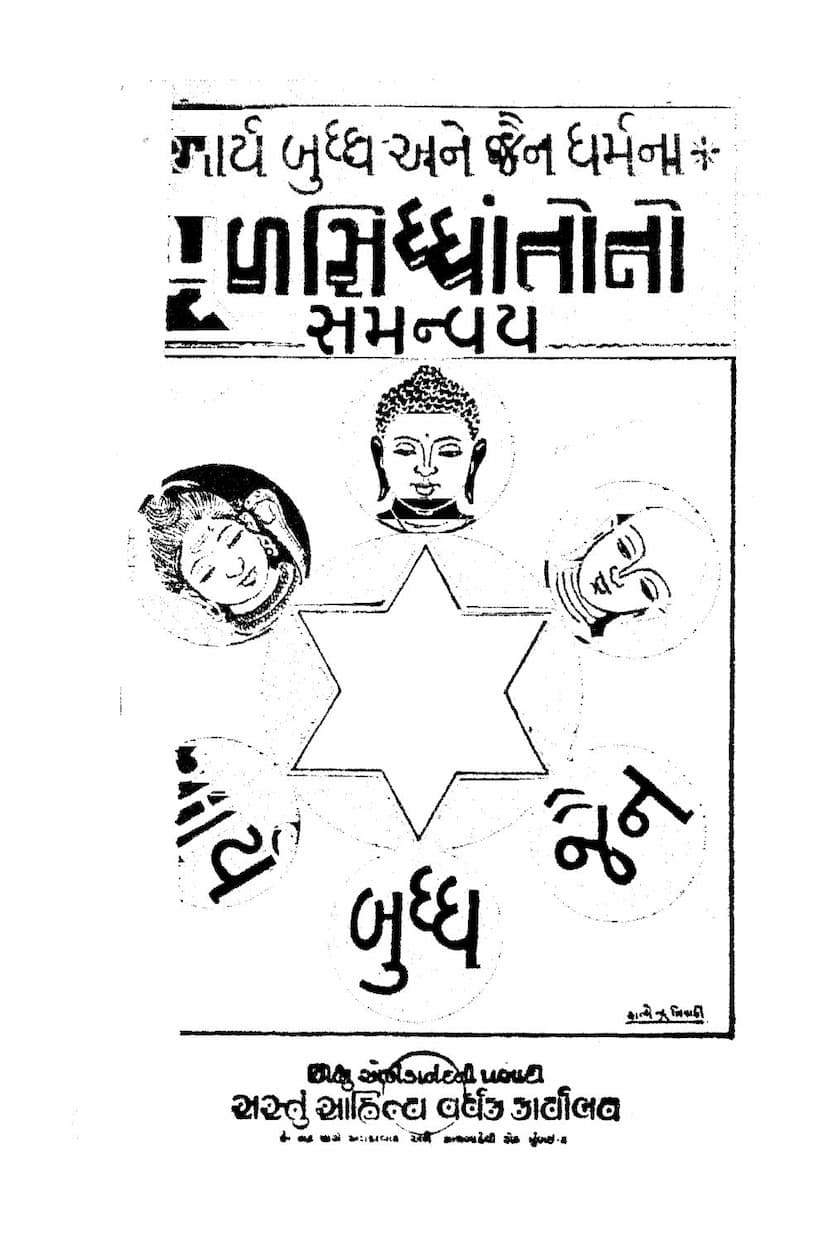Aarya Buddha Ane Jain Dharmna Mul Siddhantono Samanvay
Added to library: September 1, 2025

Summary
This document is a summary of the Gujarati book "Aarya Buddha Ane Jain Dharmna Mul Siddhantono Samanvay" (Harmony of the Core Principles of Arya Buddha and Jain Dharma) by Bechardas Doshi. The book, published by Sastu Sahityavardhak Karyalay, Mumbai, aims to find common ground between Buddhism and Jainism, and implicitly, Vedic traditions.
Key Themes and Arguments:
- The Need for Religious Harmony: The author begins by lamenting the historical divisions and misunderstandings between different religious traditions in India, particularly Jainism, Buddhism, and Vedic traditions. He uses a metaphor of estranged family members who, despite having a common origin, fail to recognize each other due to a lack of contact and the spread of misconceptions. He argues for the importance of fostering mutual understanding and respect between these traditions.
- Common Origins and Goals: Doshi posits that all these major Indian religious streams originate from a "self-centric faith" (आत्मनिष्ठा) and converge at the goal of "Nirvana" (निर्वाण). He draws parallels between rivers originating from the Himalayas and merging into the ocean, and the different religious traditions having a common source and ultimate destination.
- The Dhammapada as a Bridge: The book focuses significantly on the Dhammapada, a central text of Buddhism. The author sees it as a key text for understanding Buddhist principles and for finding parallels with Jain and Vedic thought. He discusses the meaning of "Dhamma" and "Pada" in the Dhammapada, noting the multiple interpretations of these terms.
- Dhammapada's Language and Structure: The text delves into the linguistic aspects of the Dhammapada, discussing its original Magadhi language and its relationship to other Prakrit dialects and Pali. It also analyzes the structure of the Dhammapada, detailing its various chapters (vargas) and the reasoning behind their naming.
- Comparative Analysis with Jainism and Vedic Traditions: A substantial portion of the book is dedicated to comparing verses and principles from the Dhammapada with those found in the Mahabharata (Santiparva), Jain Agamas (like Acharaanga, Uttaradhyayana, Dashavaikalika), and other Vedic texts. The author highlights striking similarities in both literal wording and philosophical concepts, emphasizing the underlying unity.
- The True Meaning of "Brahmin" and "Bhikkhu": The book explores the concept of "Brahmin" and "Bhikkhu" (monk) as presented in these traditions. It argues that true Brahminhood or monkhood is based on conduct, ethics, and inner qualities, not on birth or outward appearances. This challenges sectarian interpretations and emphasizes universal ethical principles.
- The Importance of Action and Inner Discipline: Across all traditions discussed, the author stresses the paramount importance of inner discipline, controlling the mind, ethical conduct, and virtuous actions as the path to spiritual liberation.
- Critique of Sectarianism: Doshi critiques the historical tendency of different religious sects to criticize and misrepresent each other. He argues that this has led to deep divisions and a lack of genuine understanding.
- The Role of Literature and Education: The book advocates for the dissemination of literature that promotes interfaith harmony and understanding. It calls for educational institutions and scholars to play a proactive role in this endeavor.
- The "Sastu Sahitya" (Affordable Literature) Initiative: The book is part of a series by Sastu Sahityavardhak Karyalay, which aims to make high-quality spiritual and ethical literature accessible to the masses at affordable prices. The author expresses his personal interest and satisfaction in translating the Dhammapada for this purpose.
Overall Message:
"Aarya Buddha Ane Jain Dharmna Mul Siddhantono Samanvay" is a scholarly yet accessible exploration of the shared ethical and philosophical foundations of major Indian religious traditions. It aims to bridge perceived divides by highlighting commonalities in scripture, ethical teachings, and spiritual goals, advocating for a spirit of universal brotherhood and religious tolerance. The book serves as a testament to the enduring quest for spiritual truth and the interconnectedness of various paths leading to it.